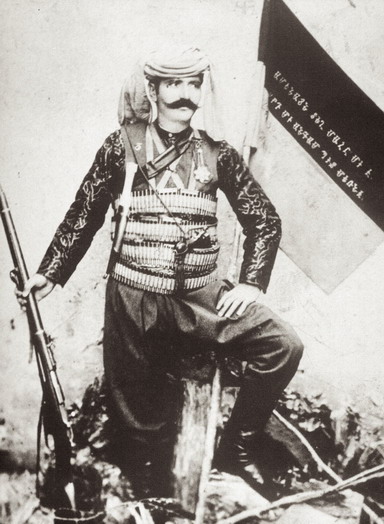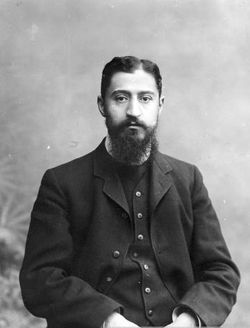|
Tsatur Aghayan
Tsatur Aghayan ( hy, Ծատուր Աղայան; – 3 December 1982) was a Soviet-Armenian historian, a professor at Yerevan State University, an academician of the Armenian Academy of Sciences, the editor of the journal ''Lraber Hasarakakan Gitutyunneri'', and a renowned scientist of the Armenian SSR (1974). Aghayan was born in the village of Pip, Dashkesan. He headed the branches of Soviet and modern history at the Institute of History (Armenian Sciences Academy), and from 1961 to 1968, he directed the Armenian branch of the Institute of Marxism-Leninism. His works are dedicated to the Armenian National Liberation Movement of the 19th and 20th centuries, Andranik Ozanian's activities, and the socioeconomic conditions of pre-Soviet Transcaucasia. He died in 1982 in Yerevan. He is buried in the Tokhmakh cemetery with Siranush Aghayan Simoni. Works *From the history of Armenian people's liberational movement, Yerevan, 1976, *Revolutionary movements in Armenia 1905-1907, Yerevan, ... [...More Info...] [...Related Items...] OR: [Wikipedia] [Google] [Baidu] |
Great Soviet Encyclopedia
The ''Great Soviet Encyclopedia'' (GSE; ) is one of the largest Russian-language encyclopedias, published in the Soviet Union from 1926 to 1990. After 2002, the encyclopedia's data was partially included into the later ''Bolshaya rossiyskaya entsiklopediya'' (or '' Great Russian Encyclopedia'') in an updated and revised form. The GSE claimed to be "the first Marxist–Leninist general-purpose encyclopedia". Origins The idea of the ''Great Soviet Encyclopedia'' emerged in 1923 on the initiative of Otto Schmidt, a member of the Russian Academy of Sciences. In early 1924 Schmidt worked with a group which included Mikhail Pokrovsky, (rector of the Institute of Red Professors), Nikolai Meshcheryakov (Former head of the Glavit, the State Administration of Publishing Affairs), Valery Bryusov (poet), Veniamin Kagan (mathematician) and Konstantin Kuzminsky to draw up a proposal which was agreed to in April 1924. Also involved was Anatoly Lunacharsky, People's Commissar of Education ... [...More Info...] [...Related Items...] OR: [Wikipedia] [Google] [Baidu] |
Transcaucasia
The South Caucasus, also known as Transcaucasia or the Transcaucasus, is a geographical region on the border of Eastern Europe and Western Asia, straddling the southern Caucasus Mountains. The South Caucasus roughly corresponds to modern Armenia, Georgia, and Azerbaijan, which are sometimes collectively known as the Caucasian States. The total area of these countries measures about . The South Caucasus and the North Caucasus together comprise the larger Caucasus geographical region that divides Eurasia. Geography The South Caucasus spans the southern portion of the Caucasus Mountains and their lowlands, straddling the border between the continents of Europe and Asia, and extending southwards from the southern part of the Main Caucasian Range of southwestern Russia to the Turkish and Armenian borders, and from the Black Sea in the west to the Caspian Sea coast of Iran in the east. The area includes the southern part of the Greater Caucasus mountain range, the entire Lesser C ... [...More Info...] [...Related Items...] OR: [Wikipedia] [Google] [Baidu] |
Academics Of Yerevan State University
An academy ( Attic Greek: Ἀκαδήμεια; Koine Greek Ἀκαδημία) is an institution of secondary or tertiary higher learning (and generally also research or honorary membership). The name traces back to Plato's school of philosophy, founded approximately 385 BC at Akademia, a sanctuary of Athena, the goddess of wisdom and skill, north of Athens, Greece. Etymology The word comes from the ''Academy'' in ancient Greece, which derives from the Athenian hero, '' Akademos''. Outside the city walls of Athens, the gymnasium was made famous by Plato as a center of learning. The sacred space, dedicated to the goddess of wisdom, Athena, had formerly been an olive grove, hence the expression "the groves of Academe". In these gardens, the philosopher Plato conversed with followers. Plato developed his sessions into a method of teaching philosophy and in 387 BC, established what is known today as the Old Academy. By extension, ''academia'' has come to mean the accumulatio ... [...More Info...] [...Related Items...] OR: [Wikipedia] [Google] [Baidu] |
1982 Deaths
__NOTOC__ Year 198 (CXCVIII) was a common year starting on Sunday (link will display the full calendar) of the Julian calendar. At the time, it was known as the Year of the Consulship of Sergius and Gallus (or, less frequently, year 951 ''Ab urbe condita''). The denomination 198 for this year has been used since the early medieval period, when the Anno Domini calendar era became the prevalent method in Europe for naming years. Events By place Roman Empire *January 28 **Publius Septimius Geta, son of Septimius Severus, receives the title of Caesar. **Caracalla, son of Septimius Severus, is given the title of Augustus. China *Winter – Battle of Xiapi: The allied armies led by Cao Cao and Liu Bei defeat Lü Bu; afterward Cao Cao has him executed. By topic Religion * Marcus I succeeds Olympianus as Patriarch of Constantinople (until 211). Births * Lu Kai (or Jingfeng), Chinese official and general (d. 269) * Quan Cong, Chinese general and advisor (d ... [...More Info...] [...Related Items...] OR: [Wikipedia] [Google] [Baidu] |
1912 Births
Year 191 ( CXCI) was a common year starting on Friday (link will display the full calendar) of the Julian calendar. At the time, it was known as the Year of the Consulship of Apronianus and Bradua (or, less frequently, year 944 ''Ab urbe condita''). The denomination 191 for this year has been used since the early medieval period, when the Anno Domini calendar era became the prevalent method in Europe for naming years. Events By place Parthia * King Vologases IV of Parthia dies after a 44-year reign, and is succeeded by his son Vologases V. China * A coalition of Chinese warlords from the east of Hangu Pass launches a punitive campaign against the warlord Dong Zhuo, who seized control of the central government in 189, and held the figurehead Emperor Xian hostage. After suffering some defeats against the coalition forces, Dong Zhuo forcefully relocates the imperial capital from Luoyang to Chang'an. Before leaving, Dong Zhuo orders his troops to loot the tombs of the H ... [...More Info...] [...Related Items...] OR: [Wikipedia] [Google] [Baidu] |
Yerevan
Yerevan ( , , hy, Երևան , sometimes spelled Erevan) is the capital and largest city of Armenia and one of the world's List of oldest continuously inhabited cities, oldest continuously inhabited cities. Situated along the Hrazdan River, Yerevan is the administrative, cultural, and industrial center of the country, as its primate city. It has been the Historical capitals of Armenia, capital since 1918, the Historical capitals of Armenia, fourteenth in the history of Armenia and the seventh located in or around the Ararat Plain. The city also serves as the seat of the Araratian Pontifical Diocese, which is the largest diocese of the Armenian Apostolic Church and one of the oldest dioceses in the world. The history of Yerevan dates back to the 8th century BCE, with the founding of the fortress of Erebuni Fortress, Erebuni in 782 BCE by King Argishti I of Urartu, Argishti I of Urartu at the western extreme of the Ararat Plain. Erebuni was "designed as a great administrative an ... [...More Info...] [...Related Items...] OR: [Wikipedia] [Google] [Baidu] |
Andranik Ozanian
Andranik Ozanian, commonly known as General Andranik or simply Andranik;. Also spelled Antranik or Antranig 25 February 186531 August 1927), was an Armenians, Armenian military commander and statesman, the best known ''Armenian fedayi, fedayi'' and a key figure of the Armenian national movement, Armenian national liberation movement. From the late 19th century to the early 20th century, he was one of the main Armenian leaders of military efforts for the independence of Armenia. He became active in an armed struggle against the Ottoman Empire, Ottoman government and Kurdish irregulars in the late 1880s. Andranik joined the Armenian Revolutionary Federation (Dashnaktustyun) party and, along with other ''Armenian fedayi, fedayi'' (militias), sought to defend the Armenian peasantry living in their ancestral homeland, an area known as Western Armenia, Western (or Turkish) Armeniaat the time part of the Ottoman Empire. His revolutionary activities ceased and he left the Ottoman Empi ... [...More Info...] [...Related Items...] OR: [Wikipedia] [Google] [Baidu] |
Yerevan State University
Yerevan State University (YSU; hy, Երևանի Պետական Համալսարան, ԵՊՀ, ''Yerevani Petakan Hamalsaran''), also simply University of Yerevan, is the oldest continuously operating public university in Armenia. Founded in 1919, it is the largest university in the country. It is thus informally known as Armenia's "mother university" (Մայր ԲՈւՀ, ''Mayr Buh''). Of its 3,150 employees, 1,190 comprise the teaching staff, which includes 25 academicians, 130 professors, 700 docents (associate professors), and 360 assistant lecturers. The university has 400 researchers, 1,350 post-graduate students, and 8,500 undergraduates, including 300 students from abroad. Instruction is in Armenian, but instruction in Russian or English for foreign students is available as needed. The academic year is from September 1 through June 30. According to University Ranking by Academic Performance (URAP), it was the top-ranked university in Armenia and the 954th in the world in 2 ... [...More Info...] [...Related Items...] OR: [Wikipedia] [Google] [Baidu] |
Dashkasan District
Dashkasan District ( az, Daşkəsən rayonu) is one of the 66 districts of Azerbaijan. It is located in the west of the country and belongs to the Ganja-Dashkasan Economic Region. The district borders the districts of Goygol, Kalbajar, Gadabay, Shamkir, and the Gegharkunik Province of Armenia. Its capital and largest city is Dashkasan. As of 2020, the district had a population of 35,400. History The district was established on 8 August 1930 and was known as ''Dastafur'' ( az, Dəstəfur) until 1956, when it was changed to Dashkasan. The capital was established as an urban facility on March 16, 1948, after the end of World War I, mainly to explore and mine iron ore and other natural resources. Administrative divisions The rayon itself was founded as an administrative center in 1930 and was named Dastafur until 1956 when it was renamed Dashkasan. In 1963, the rayon status was eliminated and Dashkasan province was merged with Khanlar District. However, in 1965, it was split ... [...More Info...] [...Related Items...] OR: [Wikipedia] [Google] [Baidu] |



